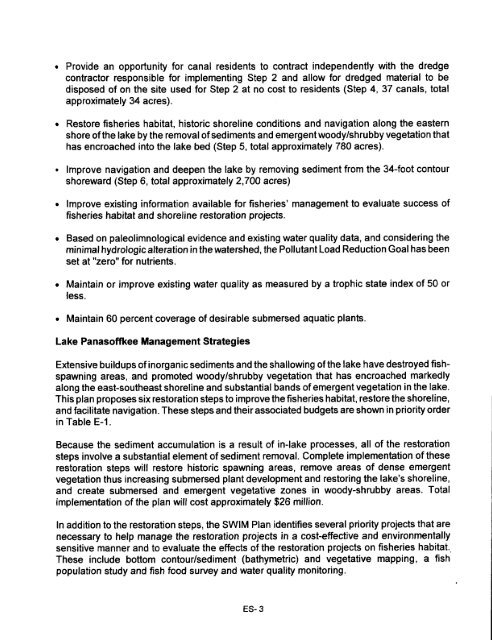Lake Panasoffkee SWIM Plan - Southwest Florida Water ...
Lake Panasoffkee SWIM Plan - Southwest Florida Water ...
Lake Panasoffkee SWIM Plan - Southwest Florida Water ...
Create successful ePaper yourself
Turn your PDF publications into a flip-book with our unique Google optimized e-Paper software.
Provide an opportunity for canal residents to contract independently with the dredge<br />
contractor responsible for implementing Step 2 and allow for dredged material to be<br />
disposed of on the site used for Step 2 at no cost to residents (Step 4, 37 canals, total<br />
approximately 34 acres).<br />
Restore fisheries habitat, historic shoreline conditions and navigation along the eastern<br />
shore of the lake by the removal of sediments and emergent woody/shrubby vegetation that<br />
has encroached into the lake bed (Step 5, total approximately 780 acres).<br />
. Improve navigation and deepen the lake by removing sediment from the 34-foot contour<br />
shoreward (Step 6, total approximately 2,700 acres)<br />
Improve existing information available for fisheries' management to evaluate success of<br />
fisheries habitat and shoreline restoration projects.<br />
Based on paleolimnological evidence and existing water quality data, and considering the<br />
minimal hydrologic alteration in the watershed, the Pollutant Load Reduction Goal has been<br />
set at "zero" for nutrients.<br />
Maintain or improve existing water quality as measured by a trophic state index of 50 or<br />
less.<br />
Maintain 60 percent coverage of desirable submersed aquatic plants.<br />
<strong>Lake</strong> PanasofFkee Management Strategies<br />
Extensive buildups of inorganic sediments and the shallowing of the lake have destroyed fishspawning<br />
areas, and promoted woody/shrubby vegetation that has encroached markedly<br />
along the east-southeast shoreline and substantial bands of emergent vegetation in the lake.<br />
This plan proposes six restoration steps to improve the fisheries habitat, restore the shoreline,<br />
and facilitate navigation. These steps and their associated budgets are shown in priority order<br />
in Table E-1.<br />
Because the sediment accumulation is a result of in-lake processes, all of the restoration<br />
steps involve a substantial element of sediment removal. Complete implementation of these<br />
restoration steps will restore historic spawning areas, remove areas of dense emergent<br />
vegetation thus increasing submersed plant development and restoring the lake's shoreline,<br />
and create submersed and emergent vegetative zones in woody-shrubby areas. Total<br />
implementation of the plan will cost approximately $26 million.<br />
In addition to the restoration steps, the <strong>SWIM</strong> <strong>Plan</strong> identifies several priority projects that are<br />
necessary to help manage the restoration projects in a cost-effective and environmentally<br />
sensitive manner and to evaluate the effects of the restoration projects on fisheries habitat..<br />
These include bottom contour/sediment (bathymetric) and vegetative mapping, a fish<br />
population study and fish food survey and water quality monitoring.<br />
ES- 3
















